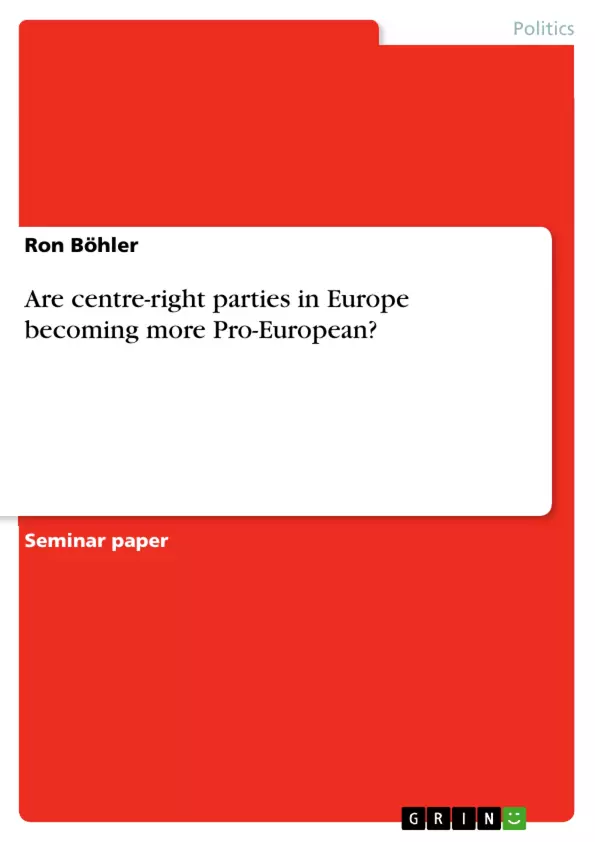This essay examines how centre-right parties in Central and Eastern Europe change in their ambitions to become a member of the European Union. The study will briefly categorize centre-right parties in post-communist Central and Eastern Europe (CEE) in order to identify relevant case studies. It is then assumed that ongoing European integration processes have an apparent impact on the domestic level, and in particular on parties´ opportunity structures within the national political arena. In the end, they inevitably adapt to these external pressures by either reacting receptive or by criticizing or rejecting the European project. Based on this assumption, the second part addresses the programmatic development and stance on Europe of major centre-right parties in Slovakia, Hungary and the Czech Republic between 1990 and 2006.
In the same way that the European Union (EU) generally has deepened its policies and widened its geographic silhouette for decades, centre-right parties would be expected to become more ‘pro-European’. In contrast, the aim of this essay is too prove this assumption wrong.
While some comprehensive studies indicate such an interrelation for Western European centre-right parties, this does not bear in cases of centre-right parties in Central Eastern European (CEE) countries. These parties were all too enthusiastic about the break-down of the communist Soviet Union and the incipient era of democratic and economic transition and proclaimed accession to the European Union as an immediate necessity in their foreign policy agendas.
Inhaltsverzeichnis (Table of Contents)
- Introduction
- Post-Communist CEE Countries between Nation and Europe
- Categorization of Centre-Right Parties in Eastern Europe
- History & Euroscepticism
- One size fits all? Empirical evidence
- Case Study I: The Czech Civic Democratic Party
- Case Study II: The Slovak Christian Democratic Movement
- Case Study III: Fidesz – Hungarian Civic Union
- Conclusion
Zielsetzung und Themenschwerpunkte (Objectives and Key Themes)
This essay aims to challenge the assumption that centre-right parties in Europe are inherently 'pro-European', particularly in the context of post-communist Central and Eastern European (CEE) countries. While Western European centre-right parties might demonstrate this trend, the essay argues that CEE counterparts have adopted a less ambitious and more Eurosceptic stance.
- The evolution of 'pro-European' attitudes among centre-right parties in CEE countries.
- The impact of historical path dependence on the development of party positions towards European integration.
- The influence of national political contexts and opportunity structures on party stances towards Europe.
- A comparative analysis of case studies in the Czech Republic, Slovakia, and Hungary.
- An assessment of the programmatic development and stance on Europe of major centre-right parties in these countries.
Zusammenfassung der Kapitel (Chapter Summaries)
- Introduction: The essay introduces the central argument that centre-right parties in CEE countries have become less 'pro-European' than their Western counterparts, despite an initial enthusiasm for European integration. The essay outlines its structure, focusing on the specific cases of the Czech Republic, Slovakia, and Hungary.
- Post-Communist CEE Countries between Nation and Europe: This section categorizes centre-right parties in Eastern Europe, highlighting their shared historical roots and their distinct position within the European political landscape. The chapter discusses the theoretical framework of path dependence, arguing that historical experiences shape party stances on Europe.
- Categorization of Centre-Right Parties in Eastern Europe: This chapter examines the classification of centre-right parties in CEE countries, highlighting their unique characteristics and their connection to Western European counterparts. It discusses the different labels applied to these parties, such as 'moderate', 'traditional conservatives', and 'liberal-conservatives'.
- History & Euroscepticism: This chapter outlines the historical context surrounding the rise of centre-right parties in CEE countries, emphasizing their involvement in the anti-communist opposition movements. It introduces the concept of path dependence and its relevance to understanding the evolution of party stances on European integration.
Schlüsselwörter (Keywords)
This essay focuses on centre-right parties in post-communist Central and Eastern Europe, examining their evolving attitudes towards European integration. Key themes include path dependence, national political contexts, opportunity structures, Euroscepticism, and programmatic development.
- Citation du texte
- Ron Böhler (Auteur), 2010, Are centre-right parties in Europe becoming more Pro-European?, Munich, GRIN Verlag, https://www.grin.com/document/376555



